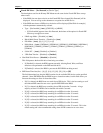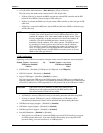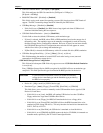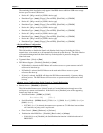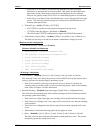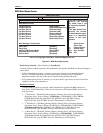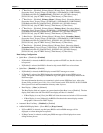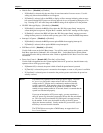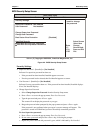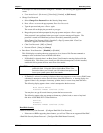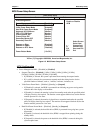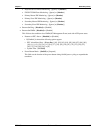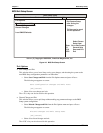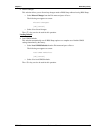
Chapter 4 BIOS Setup Utility
XTX 820 Reference Manual 83
• Halt On Error – [Disabled] or [Enabled]
∗ If [Disabled] is selected, this does not allow for user intervention if an error occurs. Use this
setting only when a known BIOS error will appear.
∗ If [Enabled] is selected, allows the BIOS to display an Error message indicating when an error
has occurred during POST (power on self test) and wait for you to respond by hitting the <F1>
key. Pressing <F1> will enter Setup and the BIOS setting can be adjusted to fix the problem.
• Hit 'DEL' Message Display – [Disabled] or [Enabled]
∗ If [Disabled] is selected, the BIOS will not place the “Hit Del to enter Setup" message on
screen during the boot process. If Quiet Boot is enabled, the Hit 'Del" message will not display.
∗ If [Enabled] is selected, the BIOS will place the “Hit Del to enter Setup" message on screen
during the boot process, to indicate when you may press “Del” to enter the BIOS Setup menus.
• Interrupt 19 Capture – [Disabled] or [Enabled]
∗ If [Disabled] is selected, the BIOS prevents option ROMs from trapping interrupt 19.
∗ If [Enabled] is selected, allows option ROMs to trap interrupt 19.
• PXE Boot to LAN – [Disabled] or [Enabled]
Use this field to turn on the LAN Boot feature. You will also need to reboot the system to see the
Intel Boot Agent device [Onboard LAN or Network: IBA…] in the Boot Device Priority Menu,
so it can be moved to the top of the boot order. Refer to Appendix B, LAN Boot Feature for more
information.
• Power Loss Control – [Remain Off], [Turn On], or [Last State]
Use this field to determine how the system responds after an AC power loss, but this feature only
operates with an ATX type power supply.
∗ If [Remain Off] is selected, the power is held off until the power button is pressed.
∗ If [Turn On] is selected, the power is restored to the computer, as soon as, AC power is available.
∗ If [Last State] is selected, power is restored to the previous power state before the power loss
actually occurred.
NOTE This feature only operates with an ATX type power supply. The term
AC power loss used in this context refers to the loss of the standby
voltage on the 5V_SB pins and is continuously monitored after the
system is turned off. If the standby voltage is not detected after 30
seconds, then it is considered an AC power loss condition. If the
standby voltage remains stable for 30 seconds, then it is assumed that the
system was switched off properly.
If you use an inexpensive ATX power supply, you may experience a
short AC power sag, where the system turns off but does not switch back
on. This can occur even when the PS_ON# signal is asserted correctly
by the module. In this case, the internal circuitry of the ATX power
supply has become confused. Usually another AC power off/on cycle is
necessary to recover from this situation.
The XTX 820 does not require a CMOS battery to support the Power
Loss Control feature.



